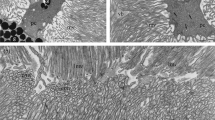Summary
In an effort to understand the cellular basis of entrainment of circadian oscillators we have studied the role of membrane potential changes in the neurons which comprise the ocular circadian pacemaker ofBulla gouldiana in mediating phase shifts of the ocular circadian rhythm. We report that:
-
1.
Intracellular recording was used to measure directly the effects of the phase shifting agents light, serotonin, and 8-bromo-cAMP on the membrane potential of the basal retinal neurons. We found that light pulses evoke a transient depolarization followed by a smaller sustained depolarization. Application of serotonin produced a biphasic response; a transient depolarization followed by a sustained hyperpolarization. Application of a membrane permeable analog of the intracellular second messenger cAMP, 8-bromo-cAMP, elicited sustained hyperpolarization, and occasionally a weak phasic depolarization.
-
2.
Changing the membrane potential of the basal retinal neurons directly and selectively with intracellularly injected current phase shifts the ocular circadian rhythm. Both depolarizing and hyperpolarizing current can shift the phase of the circadian oscillator. Depolarizing current mimics the phase shifting action of light, while hyperpolarizing current produces phase shifts which are transposed approximately 180° in circadian time to depolarization.
-
3.
Altering BRN membrane potential with ionic treatments, depolarizing with elevated K+ seawater or hyperpolarizing with lowered Na+ seawater, produces phase shifts similar to current injection.
-
4.
The light-induced depolarization of the basal retinal neurons is necessary for phase shifts by light. Suppressing the light-induced depolarization with injected current inhibits light-induced phase shifts.
-
5.
The ability of membrane potential changes to shift oscillator phase is dependent on extracellular calcium. Reducing extracellular free Ca++ from 10 mM to 1.3×10−7 M inhibits light-induced phase shifts without blocking the photic response of the BRNs.
The results indicate that changes in the membrane potential of the pacemaker neurons play a critical role in phase shifting the circadian rhythm, and imply that a voltage-dependent and calcium-dependent process, possibly Ca++ influx, shifts oscillator phase in response to light.
Similar content being viewed by others
Abbreviations
- BRN :
-
basal retinal neuron
- CT :
-
circadian time
References
Block GD, McMahon DG (1983) Localized illumination of theAplysia andBulla eye reveals new relationships between retinal layers. Brain Res 265:134–137
Block GD, McMahon DG (1984) Cellular analysis of theBulla ocular circadian pacemaker system III: Localization of the circadian pacemaker. J Comp Physiol A 155:387–395
Block DG, Roberts MH (1981) Circadian pacemaker in theBursatella eye: Properties of the rhythm and its effect on locomotor behavior. J Comp Physiol 142:403–410
Block GD, Wallace SF (1982) Localization of a circadian pacemaker in the eye of a mollusc,Bulla. Science 217:155–157
Block GD, McMahon DG, Wallace SF, Friesen WO (1984) Cellular analysis of theBulla ocular circadian pacemaker system. I. A model for retinal organization. J Comp Physiol A 155:365–378
Boulos Z, Rusak B (1982) Circadian phase response curves for dark pulses in the hamster. J Comp Physiol 146:411–417
Brown HM (1983) The role of H+ and Ca2+ inBalanus photoreceptor function. In: Grinnell AD, Moody WJ (eds) The physiology of excitable cells. Alan R. Liss, New York, pp 329–342
Brown JE, Blinks L (1974) Changes in intracellular free calcium concentration during illumination in invertebrate photoreceptors. Detection with aequorin. J Gen Physiol 64:643–665
Corrent G, McAdoo DG, Eskin A (1978) Serotonin shifts the phase of the circadian rhythm from theAplysia eye. Science 202:155
Eskin A (1972) Phase shifting a circadian rhythm in the eye ofAplysia by high potassium pulses. J Comp Physiol 80:353–367
Eskin A (1977) Neurophysiological mechanisms involved in the photoentrainment of the circadian rhythm from theAplysia eye. J Neurobiol 8:273–299
Eskin A (1979) Circadian system of theAplysia eye: Properties of the pacemaker and mechanisms of its entrainment. Fed Proc 38:2573–2579
Eskin A (1982) Increasing external K+ blocks phase shifts in a circadian rhythm produced by serotonin or 8-benzylthio-cAMP. J Neurobiol 13:241–249
Eskin A, Harcombe E (1977) Eye ofNavanax: Optic activity, circadian rhythm and morphology. Comp Biochem Physiol 57A: 443–449
Eskin A, Takahashi JS (1983) Adenylate cyclase activation shifts the phase of a circadian pacemaker. Science 220:82–84
Eskin A, Corrent G, Lin C-Y, McAdoo DJ (1982) Mechanism for shifting the phase of a circadian rhythm by serotonin: Involvement of cAMP. Proc Natl Acad Sci USA 79:660–664
Eskin A, Takahashi JS, Zatz M, Block GD (1984) Cyclic GMP mimics the effects of light on a circadian pacemaker in the eye ofAplysia. J Neurosci 4:2466–2471
Hagiwara SH, Byerly L (1981) Calcium channel. Annu Rev Neurosci 4:69–125
Jacklet JW (1969) Circadian rhythm of optic nerve impulses recorded in darkness from the isolated eye ofAplysia. Science 164:562–563
Jacklet J, Lotshaw DP (1981) Light and high potassium cause similar phase shifts of theAplysia eye circadian rhythm. J Exp Biol 94:345–349
McMahon DG, Block GD (1982) Organized photoreceptor layer is not required for light responses in three opisthobranch eyes. Soc Neurosci Abstr 8:33
McMahon DG, Block GD (1984) Circadian pacemaker entrainment inBulla: light and serotonin affect the membrane potential of putative circadian pacemaker neurons. Soc Neurosci Abstr 10:292
McMahon DG, Block GD (1987) TheBulla ocular circadian pacemaker. II. Chronic changes in membrane potential lengthen free running period. J Comp Physiol A 161:347–354
McMahon DG, Wallace SF, Block GD (1984) Cellular analysis of theBulla ocular circadian pacemaker system: Neurophysiological basis of circadian rhythmicity. J Comp Physiol A 155:379–385
Portzehl H, Caldwell PC, Ruegg JC (1964) The dependence of contraction and relaxation of muscle fibers from the crabMaia squinado on the internal concentration of free calcium ions. Biochim Biophys Acta 79:581–591
Roberts MH, Block GD (1983) Mutual coupling between the ocular circadian pacemakers ofBulla gouldiana. Science 221:87–89
Roberts MH, Block GD (1986) Analysis of mutual circadian pacemaker coupling between the two eyes ofBulla. J Biol Rhythms 1:55–75
Rusak B, Groos G (1982) Suprachiasmatic stimulation phase shifts rodent circadian rhythms. Science 215:1407–1409
Author information
Authors and Affiliations
Rights and permissions
About this article
Cite this article
McMahon, D.G., Block, G.D. TheBulla ocular circadian pacemaker. J. Comp. Physiol. 161, 335–346 (1987). https://doi.org/10.1007/BF00603959
Accepted:
Issue Date:
DOI: https://doi.org/10.1007/BF00603959




